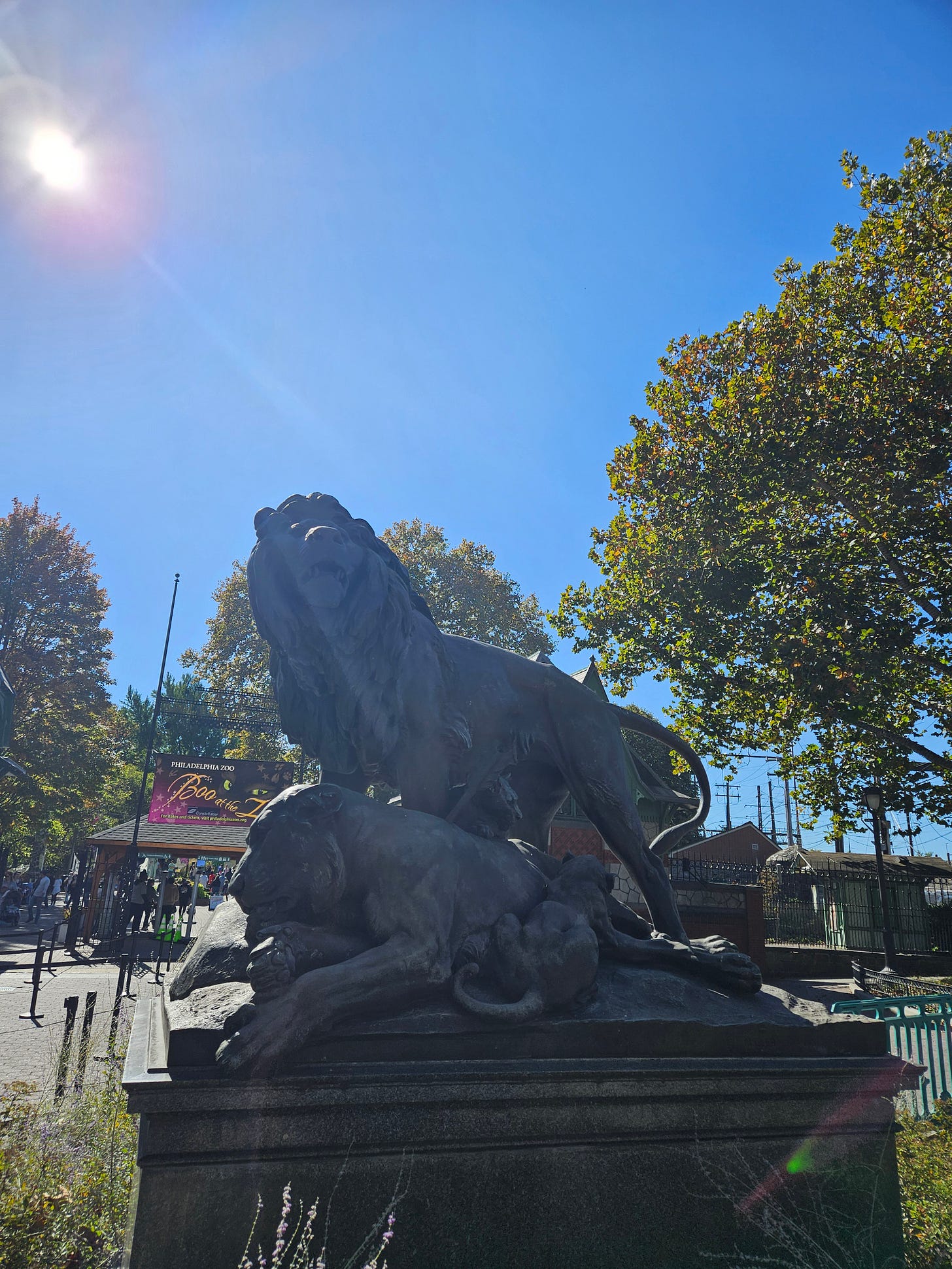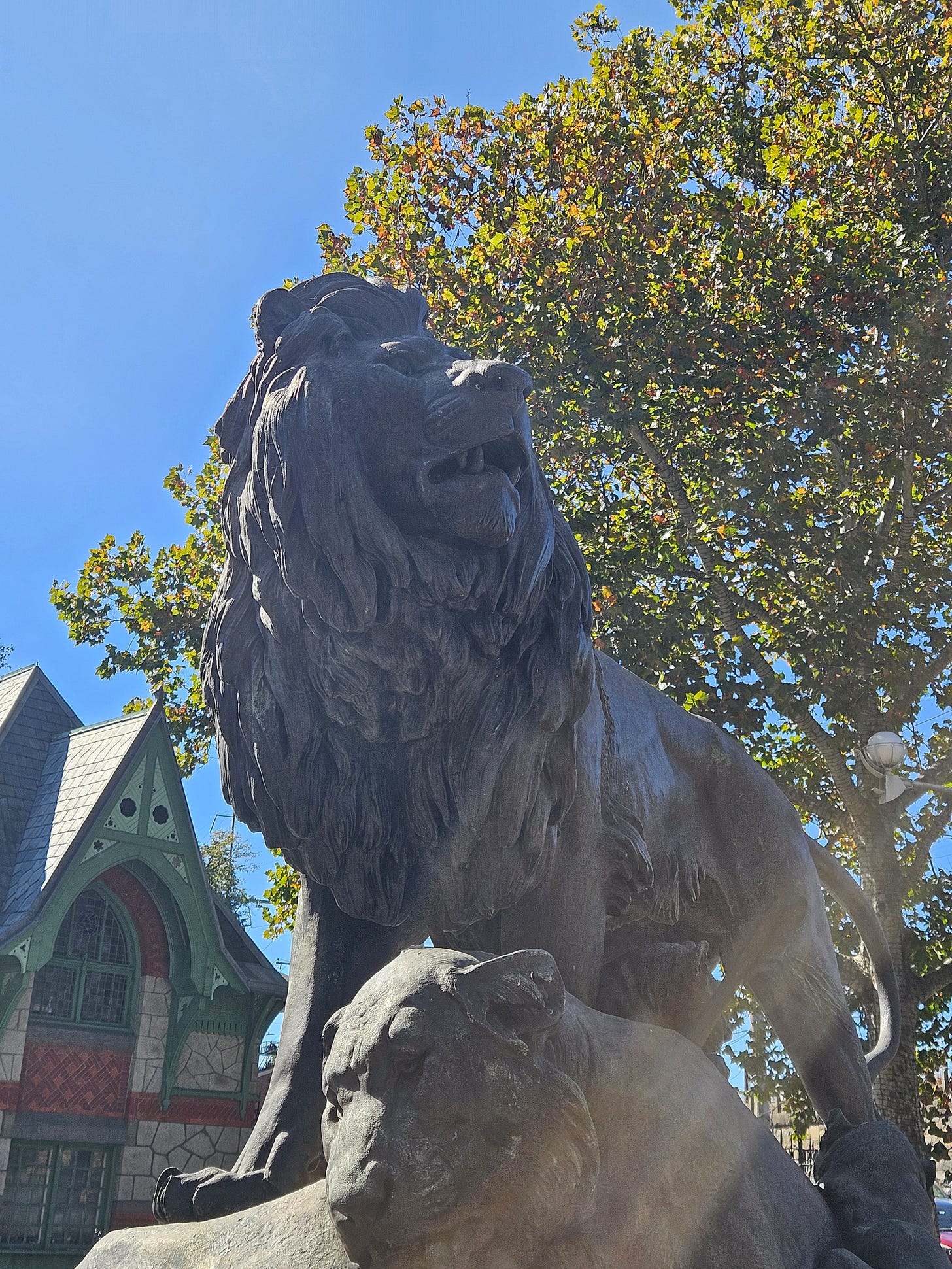Content Warning: The end of this post is going to be uncharacteristically dark, including discussion of death, environmental problems, and existential themes. If you want to avoid this, stop reading after I give my overall score.
Also, a note about the title of this post. Usually, when I can find a statue’s official name, I use that as the title of the review. This statue has an official name, but using it would reveal its hidden meaning. This secret completely changed my viewpoint on this statue, and I want to give you the chance to experience the statue without knowing it, as I initially did. I’m therefore hiding the title until the background section.
(Full view)
(Side view)
(Front view)
Location: This statue graces the front entrance of the Philadelphia Zoo. I’ve already said my piece about the zoo, so let’s move on.
Realism: Excellent. Absolutely excellent.
Perhaps it’s not surprising that a zoo would give me one of the best, most realistic lions I’ve seen. The proportions of the lions are exactly on point — not too slender, not too bulky. They all have well-shaped faces, with perfect ears, lovely noses, and a sign of whiskers. The male has a realistic mane and two accurate sets of fangs.
The lions’ legs are powerful, with detailed paws. Their tails is unusually well-pronounced, with a proper tuft. Really, I just can’t praise these statues enough, in terms of realism.
The only thing that I could remotely criticize is the fact that these lions are framed as a nuclear family — mom, dad, and kids. But I’m willing to allow that — we can just assume that the rest of the pride is off hunting or something. Besides, it’s not very common to even see lionesses or cubs, so that basically cancels out the complaint.
You know, I gave Lion Crushing a Serpent 10/10 for realism, and obviously this one will get that as well. But just to be clear, this one is WAY better. If I wasn’t holding myself to arbitrary consistency standards, this one might get more than ten. Subscore: 10/10.
Pose: Out of context, the male lion has a pretty much perfect pose. He’s standing in a noble, dignified way that befits his strength. But unlike Lion Crushing a Serpent, there’s no excessive aggression or violence. There’s a hint of it from his fangs — but it’s only a hint. It reminds you of the power and danger of the King of Beasts without seeming over the top. A smaller detail — I like the way the male’s tail hangs. Almost like it’s swatting away a fly — which is its purpose. Does this statue do everything right?!
Actually, when I first saw this statue, I did see something wrong with the pose. The male lion was standing up, while the female was lying down. The male seemed to be the protector, while the female was relaxing. This, of course, isn’t how it works in real life — lionesses do the hunting, male lions are infamously lazy. The whole thing seemed to be an attempt to project human masculinity ideals onto lions — not great! This probably would have cost it a point or two.
But it turns out this is NOT what the statue was going for at all. I wanted to share my first impressions, divorced from context, but the context completely obliterates this complaint and allows it to get full marks. Subscore: 10/10.
Aesthetics: On point. No notes. Based and lionpilled.
Very nice bronze casting, I like the way the sun hits it. I don’t want to repeat the whole realism section, so I’m just going to say that it makes me feel like I’m looking at a real lion. But more than that, it captures their spirit — both their aggression and their quiet dignity at rest.
And I’m also impressed at how much I feel their family togetherness. They’re so close. Looking at their faces, I can see how the cubs cling to their mother and how the father wants to protect his whole family. First time I’m saying this about a piece here, but these statues are wholesome. This statue makes me care about this lion family.
Which makes it that much more painful knowing the truth behind this statue.
I’m going to do the overall score and teaser before the background, so people who want to avoid the sad part can.
Overall Score: 10/10. Genuinely perfect. This is not just a realistic depiction that captures all facets of the lion, it’s a unique piece that shows lionesses and cubs and family bonds in a lion pride. This really sets the bar for lion statues, and I’ll be surprised if I find another one this good. It’s all you’d want before you enter the zoo.
Coming Up Next: At a local pizza place, disembodied heads hit a possible new low.
If you don’t want to hear the sad story, stop reading now. The background behind this statue is right under the caution sign.
Here we go. Don’t say I didn’t warn you.
Background: As expected, the Association for Public Art had the deets. But I didn’t expect how sad they’d be.
This statue was sculpted by German scupltor Franz Alexander Friedrich Wilhelm Wolff (gesundheit) who was nicknamed “Animal-Wolff” (because he scuplted animals, not because he was a party animal) (enjoy those jokes, there won’t be many more).
The statue won first place at the 1873 Vienna International Exhibition. The original was put on display at the Berlin Zoo. Apparently, architect Herman J. Schwarzmann liked it as much as I do, and had a casting made in Philly.
And what was the title of the statue?
The Dying Lioness
Oh god. Oh God.
Yes, that’s right. The lioness isn’t resting, like I thought. She’s DYING.
Additional details don’t help. I couldn’t possibly put it any better than Fairmount Park Art Association’s Annual Report on the subject: “the maternal instinct, stronger than death, [which] has caused the dying lioness to give her last strength to the nourishment of her young; over the mother and the whelps stands the lion, the prominent figure of the group, who roars defiance, grief and rage.”
I mean…what can I even say about that? The lioness is sacrificing her life so her children can live. With that knowledge, my understanding of the statue completely changes. The lioness is not lazy, or being protected. She’s going to die soon. Her cubs are cherishing their last moments with her. And her mate isn’t just growling, but rather roaring in grief from one of the most painful things in life.
I know I’m anthropomorphizing here. But I don’t really care all that much. Did you know that all mammals take care of their young? That unites us all, from platypuses to kangaroos to bats to whales to humans to lions. We can’t speak to lions. There’s much we’ll never understand about them. But we can understand one thing — the bond between parents and children.
This adds so much more meaning to the statue. It’s not just capturing a moment in the daily life of a lion. The statue is asking us to feel their pain. And I think that’s important.
Thoughts on the Environment:
Lions are listed as vulnerable species by the ICUN, with only 20 to 30 thousand alive in the wild. And why is that? The usual suspects — poaching, pollution, overdevelopment, climate change (wow look I mentioned climate change, NCSE give me money pls).
One purpose of a zoo is entertainment. If you ignore the placards at the zoo and just laugh at silly animal antics, I’m not judging you. Life is hard, and I have nothing against escapism.
But there is another important purpose - getting you to feel empathy for animals. Zoo animals serve as ambassadors for the wild. They let us see what’s usually far away from us to convince us to care. There is plenty of debate about whether captivity is beneficial or harmful — look it up if you want, I’m not in the mood. I come on the pro-captivity side myself, and part of that is because of the unique value to getting to see animals for yourself. I think many people won’t care about preserving the wild unless they can personally see a slice of it. It reminds you what you’re fighting for.
If I was a normal writer, this would be the part where I chastise you for not caring about the environment. But everyone has a lot going on, and I’m not really interested in telling anyone how to live their life. So, this is all I want you to do: remember what you’re feeling. If hearing about this lioness dying and her mate’s and cub’s grief makes you feel something — just sit with that feeling for a little while. That’s all I ask.
Thoughts on Death, Legacy, and the Real Meaning of “Nerd”:
And just like zoos, I think this post has revealed another meaning for my silly Substack.
What is the point of this publication? Why am I reviewing lion statues? Why so many praise and condemnations for something so pointless?
Well, sometimes it is pointless. Sometimes there’s a history lesson only I could possibly care about. Sometimes I’m just speculating about a silly little head. Sometimes there’s no real meaning to find.
But sometimes…Sometimes you get this. A masterful portrayal of grief. I think every tiresome bust is worth it for something like this.
And that brings me to another point. The Philadelphia Zoo gets 1.3 million visitors per year. Most of those people probably see The Dying Lioness. How many know the story behind it? I’m guessing not many.
I feel kind of bad for poor Animal-Wolff. He poured his heart and soul into this thing and made something so beautiful and sad. But most people probably don’t know about it. His passion has been forgotten.
Bear with me for a second here — what does “nerd” really mean? I don’t think it’s just “smart.” It has to do with a single-minded, mockable interest, verging on obsession. It’s not useful to be obsessed by, say, lion statues, or dinosaurs, or an obscure French cartoon from 2003 (yes, the latter two also apply to me).
And so, it’s possibly not the best use of my time to complain about lion statues. Maybe I shouldn’t be doing this. Maybe the Association for Public Art shouldn’t bother recording the meanings of statues nobody cares about.
But I think somebody has to. Why? Neurocientist David Eagleman said, “There are three deaths: the first is when the body ceases to function. The second is when the body is consigned to the grave. The third is that moment, sometime in the future, when your name is spoken for the last time.”
An estimated 117 billion people have lived on this planet. How many historical figures can you name, off the top of your head? I bet only geniuses would get more than a few hundred. Most people have already been forgotten. One day, it will happen to me. I hope it’s not soon.
Who will remember me? People who are obsessed by what I did. People who look for hidden meanings everywhere. People like the Association for Public Art. Nerds who don’t have anything better to do.
So maybe that’s why I really run this blog. Because I don’t think the sculptors who made these lions deserve to be forgotten just yet.








What a truly beautiful piece of writing. It justifies our interests from hummingbirds to helium balloons to history. We are human--we care about things. If we do not care, are we really human?